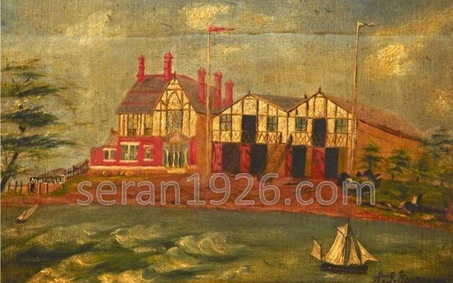Messrs. Frank Maynard
“At Chiswick, Rotarian Maynard has built some very fine and fast boats."
Mr. John Avila A.M.I.E.E., Secretary, Marine Motoring Association, 1926
Mr. John Avila A.M.I.E.E., Secretary, Marine Motoring Association, 1926
Francis Goodwin Maynard, master boat builder & waterman,
established the Devonshire boat-house at the east end of Strand-on-the-Green in
1869. Maynard specialised in building, maintaining and hiring traditional river
craft including canoes, gigs, skiffs, dinghy’s and small sailing vessels and
quickly established an enviable client base including Earl Cairns, Prince
Giardinelli and the Rothschild family. He organised rowing regatta’s and by
providing changing facilities and catering for spectators, Maynard’s yard
became a fixture of Thames rowing circuit in the 1870’s and 1880’s. He worked
closely with a number of local rowing and sailing clubs and from 1878 his
boat-house was the headquarters of the Anglian Boat Club. In addition, he also
built and exhibited innovative craft including the Willesden Patent Waterproof
Paper Boats and Jackson’s Patent Concave Canoes. Maynard died in 1886 at the
relatively young age of forty-six, after which the business was run by his
widow Emma and their three sons.
By the late 1890’s Francis Thomas Maynard, or Frank Maynard as
he was known, had taken over the running of his father’s business. His
experience of yacht building and reputation for quality craftsmanship brought
work from some of the leading yacht designers of the day including H. W.
Ridsdale, Alfred Mylne, G. Umfreville Laws, and Linton Hope. Maynard’s yard
built a number of International Six Metre yachts including the Mylne designed
‘Sibindi’ which competed in the 1908 Olympic Games at Ryde and the Linton Hope
designed 'Edelweiss II' and 'Tan-fe-Pah' which won gold and silver medals
respectively in the 1920 Olympic Games at Antwerp.
Increasingly however, the yard focussed on building fast
motor launches, one of the earliest being the 30 ft. hull of ‘Scolopendra’,
Thornycroft’s entrant in the inaugural 1903 Harmsworth Trophy race. Maynard
also built a number of launches designed by James A. Smith, Official Measurer
of the Marine Motoring Association, as well as several of his own design and
was actively involved in the early R. Y. C. Reliability Trials in Southampton
Water. In 1908 he built ‘Gyrinus II’
designed by Tom Thornycroft, which won two gold medals in the 1908 Olympic
Games at Ryde and took first place at the 1909 Monaco Motor Boat Meeting. He
also built the Thornycroft designed ‘Miranda IV’ one of the earliest racing
hydroplanes and ‘Batboat III’, built as a contender for the 1914 British
International Trophy. During the First World War, Maynard’s yard was one of a
number to build Coastal Motor Boats for the Admiralty, building 40 ft. and the
larger 55 ft. twin screw variants which were delivered in 1918.
Maynard had entered into partnership with the Chiswick based
naval architect, Higley Halliday M.I.N.A., in 1911 and whilst the arrangement
was not exclusive he built the majority of Halliday’s designs for motor yachts,
launches and more utilitarian commercial vessels until the partnership
dissolved in 1926. By mid the 1920’s Maynard was an established figure within
the industry, Vice-President of the Ship and Boat builders’ Association
and when The Duke of York’s International Trophy races came to the Thames at
Chiswick in 1926, he was appointed a delegate to the Marine Motoring
Association. The economic climate in the late 1920’s and early 1930’s was
challenging. Demand for bespoke new builds declined and there was greater
interest in conversions and affordable, standardised cruiser designs which
favoured the larger yards. Nonetheless Maynard successfully continued the
business until his retirement in 1938, aged sixty-two, ending nearly seventy
years of boat building by the Maynard family at Strand-on-the-Green.
